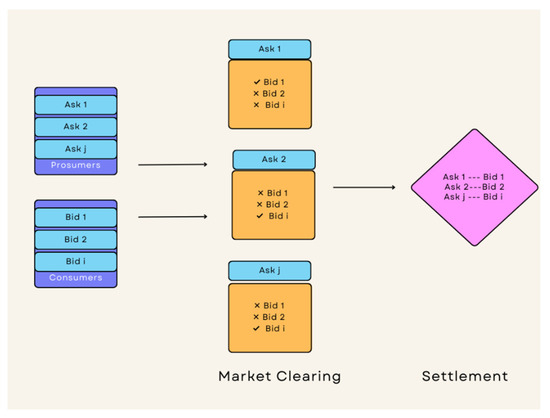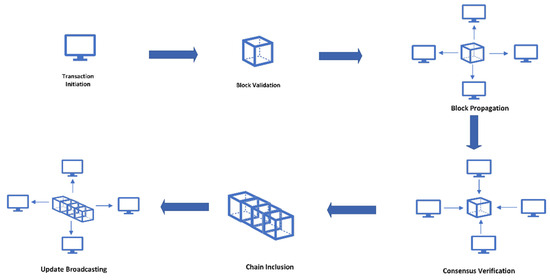You're using an outdated browser. Please upgrade to a modern browser for the best experience.
Please note this is a comparison between Version 1 by Suprava Chakraborty and Version 2 by Catherine Yang.
Advancing the sustainable energy transition is a major need in nations that are constantly evolving and developing in terms of their energy economy. India has been chosen for the purpose of analysis due to the heterogenous nature of its polity, topographies, infrastructural capabilities and diverse framework. Blockchain technology that facilitates a transparent transition is incorporated on various upcoming platforms. This is backed up by peer-to-peer trading of energy providing a prosumer with an autonomous environment.
- peer-to-peer (P2P) energy
- renewable energy
- distribution companies (DISCOMs)
1. P2P Enabled by Blockchain
A reliable P2P energy trading platform may be established using blockchain due to its decentralized and transparent nature, which links consumers and prosumers, promoting the use of renewable energy sources. Prosumers can directly sell excess energy to nearby consumers, encouraging the growth of decentralized clean energy generation and contributing to India’s sustainability goals. By eliminating intermediaries, such as utilities and energy companies, the P2P trading process becomes more efficient, cost-effective and transparent [1][63]. The implementation of smart contracts further enhances automation and trust in the trading process [2][64]. Figure 16 illustrates the P2P energy trading process on a blockchain-based platform. Prosumers create “asks” to offer their surplus energy, while consumers place “bids” to purchase the energy. The blockchain’s decentralized and immutable nature ensures secure and trustworthy transactions by permanently recording the matches between “asks” and “bids.”

Figure 16.
Blockchain technology for P2P.
Several pilot projects and demonstrations were conducted to test the feasibility and viability of P2P energy trading in different parts of the country. These projects aimed to empower consumers to directly buy and sell excess energy to their neighbors, potentially reducing transmission losses and promoting the use of renewable sources. However, the adoption of P2P energy trading on a larger scale in India depended on various factors, including regulatory frameworks, technical infrastructure, consumer awareness and the involvement of utilities. The energy sector in India is complex and heavily regulated, which could impact the pace of implementation of new energy trading models. These have been discussed in previous sections extensively.
The relationship between peer-to-peer (P2P) trading and blockchain technology is symbiotic as blockchain enables a decentralized and provides a secure network facilitating direct energy trade between participants without intermediaries [3][65]. Smart contracts play a pivotal role in automating transactions, managing pricing, settlement and billing, ensuring trust and efficiency in the trading process. However, there are some challenges, which include scalability, interoperability with existing energy infrastructure, regulatory compliance, initial setup costs and data privacy [4][66]. Within the framework of blockchain-enabled P2P energy trading, integrate automated power trading algorithms can be considered. These algorithms can significantly enhance the efficiency and accuracy of energy transactions by automating real-time pricing adjustments and optimizing energy allocation. By integrating such algorithms into the blockchain platform, participants can have seamless and autonomous trading interactions [5][67]. For example, if a prosumer wants to sell extra energy produced by solar panels to customers, the automated power trading algorithm would access the current energy demand in the local area and set prices accordingly as programmed. Consumers looking to buy energy would have their preferences and price constraints programmed into the algorithm, and, when these preferences match with the prosumer’s offerings, a trade is automatically executed with better efficiency, optimizing trading and reducing intermediaries. Moreover, discussing the advantages and potential dangers that arise from automated power trading is essential. The advantages include improved market efficiency and responsiveness as automated algorithms can quickly adjust prices based on real-time demand and supply conditions, leading to better resource allocation and facilitating the adoption of renewable energy sources for a more sustainable future [5][67].
Incorporating smart meters into the P2P energy trading ecosystem offers several benefits, like enabling real-time monitoring of energy consumption, accurate billing and transparent data exchange between consumers and prosumers [6][68], allowing consumers to make informed decisions about their energy usage, aligning it with renewable energy availability, while prosumers receive fair compensation. The transparent data exchange enhances trust among participants, fostering cooperation and contributing to a more sustainable energy landscape. Overall, these advancements in blockchain-based P2P energy trading can empower individuals and communities to actively shape a greener and more resilient energy future in India’s Green Revolution. Figure 27 outlines the fundamental steps in the blockchain processing flow, showcasing how transactions are initiated, validated and added to the blockchain through consensus mechanisms, ultimately leading to an updated and consistent distributed ledger across the network.

Figure 27.
Structure of blockchain.
Blockchain’s resistance to modification stems from its immutability. Once a block is added to the chain, any change to its data alters its cryptographic hash, making tampering evident. The decentralized nature and consensus mechanisms ensure security as controlling the majority of the network is impractical [7][61]. This immutability ensures the reliability and transparency of the blockchain, making it ideal for various applications [1][63].
2. Advantages, Disadvantages and Challenges of P2P Energy Trading
In theour previous discussions, the system and setups of open-sourced electricity have been elaborated. They are mainly in accordance with the needs and the infrastructural capacity of the country. However, it is also important to highlight what advantages and disadvantages this technology offers over other conventional as well as non-conventional systems.
2.1. Advantages of Peer-to-Peer Energy Trading for Decentralized Electricity Systems
P2P energy trading falls in an entirely new sector of “energy sharing”. With a developing economy, the country needs certain things to be easily available in order to grow. Viewing electricity as a commodity is the first step to take. Many countries have adopted policies to incorporate consumer-friendly techniques for the benefit of their nation and to battle climate change. Various other benefits have been highlighted as follows:
-
Reduces the peak and minimizes various power losses faced by the network.
-
Demand can be shifted to various other participating renewable energy sources (RES) and a single institution is not burdened by load.
-
Ensures grid stability as the entire network cannot be broken down by the failure of one supplier.
-
Such a decentralized model proves to be an advantage in the event of a natural calamity as harm is not imposed upon the entire network in case some of them are subjected to an unfortunate circumstance. Similarly, leakage of data can be prevented if a cyberattack occurs to disrupt the convention.
2.2. Disadvantages and Challenges in Implementing P2P Energy Sharing for Decentralized Electricity Systems
India is one of the few countries that has witnessed massive growth in all major sectors that constitute and run a nation. Speaking from an economic point of view, the GDP of the country has been on a constant rise since the Economic Depression of 2008–2009 [11][73], where there was a decrease of more than 2 percentage points. A comeback was made after the Government and the Reserve Bank of India took drastic measures. The country also improved the general life and well-being of its citizens by ensuring easy access of basic amenities to all [12][74].
Since 2000, around half a billion people are now connected to the grid and have access to electricity. As announced in 2018 by the Indian Prime Minister, the country has achieved its target ahead of schedule and now provides electricity to all villages [13][75]. This is undoubtedly an extraordinary feat that makes a mark in the history of power and energy. People in rural areas of the country have shifted from unsustainable kerosene lamps and candles to light bulbs. This in turn would help in reducing costs for buying oil to run lamps, which would reduce the costs of an average rural household by 11.2 percent. This would amount to a total of USD 69 billion savings on lighting alone [14][76]. However, even after connecting every village to the grid, the country still faces an emergency.
With the centralized main grid being highly relied upon, most rural and even urban areas face constant power outages. Despite all this progress, a large number of people still remain poor and with glow-less bulbs. Even with the present scenario of power generation in the country, 80 percent is obtained from unsustainable resources like coal and natural gas. This leads to highly detrimental impacts on the environment, contributing to global CO2 emissions and global warming. India ranks highly for producing GHG gasses and, in contrast, ranks extremely low on the Human Development Index [15][77]. So, even if it can be rightfully argued that the majority of the population is now connected to the grid, it does not directly benefit or ensure the well-being of the people.
There is a need for a system of energy generation that is convenient and can be a passive part of people’s lives. Such a method is conceptualized by P2P energy sharing where local energy producers are average households and electricity is viewed as a commodity.
